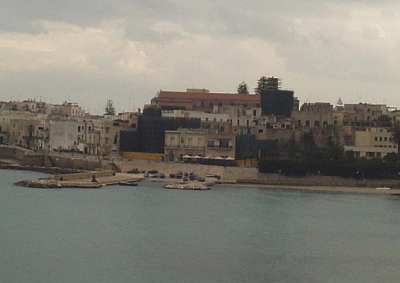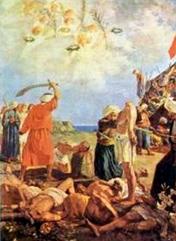 Da min kone og jeg i februar 2006 var i Lecce i Puglia (Italias hæl), tok vi en dagstur til Otranto (på østkysten av hælen). Otranto er berømt for det vakre mosaikkgulvet i domkirken og for det som hendte i august 1480: Tyrkerne kom og angrep byen, og innbyggerne fikk valget mellom å bli muslimer eller blir drept. Alle (800) valgte martyrdøden, og i et kapell i kirken er deres levninger oppbevart. I kapellet var den en innsamling til arbeidet med å få disse helgenene offisielt helligkåret, og det skjedde faktisk i juli i år, og 14. august i år var derfor en stor dag for Otranto. (Bildet over viser den gamle kirken i Otranto, bildet under er fra kapellet med alle hodeskallene.)
Da min kone og jeg i februar 2006 var i Lecce i Puglia (Italias hæl), tok vi en dagstur til Otranto (på østkysten av hælen). Otranto er berømt for det vakre mosaikkgulvet i domkirken og for det som hendte i august 1480: Tyrkerne kom og angrep byen, og innbyggerne fikk valget mellom å bli muslimer eller blir drept. Alle (800) valgte martyrdøden, og i et kapell i kirken er deres levninger oppbevart. I kapellet var den en innsamling til arbeidet med å få disse helgenene offisielt helligkåret, og det skjedde faktisk i juli i år, og 14. august i år var derfor en stor dag for Otranto. (Bildet over viser den gamle kirken i Otranto, bildet under er fra kapellet med alle hodeskallene.)
That day the Church remembers and venerates the approximately eight hundred martyrs of Otranto, in Puglia, pressured to renounce the faith after the crushing assault of the Ottoman soldiers. They were exhorted by blessed Antonio Primaldo, an elderly tailor, to persevere in Christ, and thus through decapitation they obtained the crown of martyrdom.
 The martyrdom of these eight hundred men took place in 1480, on August 14, the day of their liturgical commemoration. It was because of them that five centuries later, in 1980, John Paul II visited Otranto, the Italian city in which they were martyred.
The martyrdom of these eight hundred men took place in 1480, on August 14, the day of their liturgical commemoration. It was because of them that five centuries later, in 1980, John Paul II visited Otranto, the Italian city in which they were martyred.
And this year, on July 6, Benedict XVI definitively authenticated their martyrdom, with a decree promulgated by the congregation for the causes of the saints.
But who were the eight hundred men of Otranto? And why were they killed? Their story is of extraordinary relevance – just like the conflict between Islam and Christianity, in the midst of which they sacrificed their lives. … …
Ahmed condemned all the eight hundred prisoners to death. The following morning, they were led with ropes tied around their necks and their hands bound behind their backs to the Hill of Minerva, a few hundred meters outside of the city. De Marco writes:
 “All of them repeated their profession of the faith and the generous response they had given at first, so the tyrant commanded that the decapitation should proceed, and, before the others, the head of the elderly Primaldo should be cut off. Primaldo was hateful to him, because he never stopped acting as an apostle toward his fellows. And before placing his head upon the stone, he told his companions that he saw heaven opened and the comforting angels; that they should be strong in the faith and look to heaven, already open to receive them. He bowed his head and it was cut off, but his corpse stood back up on its feet, and despite the efforts of the butchers, it remained erect and unmoving, until all were decapitated.»
“All of them repeated their profession of the faith and the generous response they had given at first, so the tyrant commanded that the decapitation should proceed, and, before the others, the head of the elderly Primaldo should be cut off. Primaldo was hateful to him, because he never stopped acting as an apostle toward his fellows. And before placing his head upon the stone, he told his companions that he saw heaven opened and the comforting angels; that they should be strong in the faith and look to heaven, already open to receive them. He bowed his head and it was cut off, but his corpse stood back up on its feet, and despite the efforts of the butchers, it remained erect and unmoving, until all were decapitated.»

Et eksempel til efterfølgelse!
Det burde få ethvert katolsk medlem av Interfaith-bevegelsene til å tenke seg om.
På samme måte var det med fransiskanerne som reiste til sultanen for å omvende ham. De reiste med evangelisering som mål, ikke med dialog og respekt for falske religioner.
«That day the Church remembers and venerates the approximately eight hundred martyrs of Otranto, in Puglia, pressured to renounce the faith after the crushing assault of the Ottoman soldiers. They were exhorted by blessed Antonio Primaldo, an elderly tailor, to persevere in Christ, and thus through decapitation they obtained the crown of martyrdom.»
En nåtidig versjon av dette ville f.eks være:
» That day the Church remembers and venerates the approximately eight hundred ecumenists of Otranto, in Puglia, dialogued into agreeing that Islam is a venerable religion, that Muslims should be encouraged to be good Muslims and that it is not neccessary to convert to Catholicism for the sake of one’s salvation after the arguments were presented by the Muslim delegates. They were exhorted by Kasper and Etchegaray, Jaques Dupuis S.J and Teilhard de Chardin, all elderly dialoguers, to dialogue, understand and honor diversity as best as they could, and thus through their ecumenical breakthroughs, dialogue and respect for religious liberty as presented by the Spirit of Vatican II, they obtained the crown of unity in diversity.»